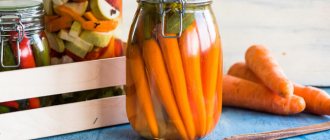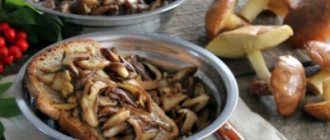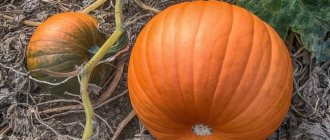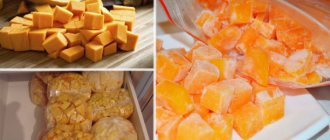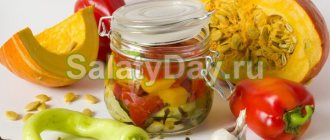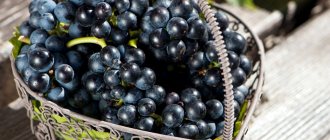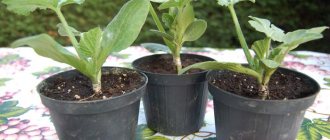There are many plants that decorate gardens at different times of the year. Climbing species of shrubs and flowers always add special charm to the site A house wall, gazebo or arch entwined with vines creates a unique atmosphere of country coziness.
Decorative pumpkin is just one of these plants. Climbing shoots will decorate the garden or vegetable garden from June to early November. And in mid-autumn, bright colorful fruits will add color and it is not at all difficult to grow. If you don't already have one of these plants on your property, consider adding this colorful accent to your landscape.
Plant characteristics
Decorative pumpkin is a fast-growing vine that forms shoots up to 6 meters long. Plants are grown primarily as annuals. This variety of pumpkins differs from ordinary ones in the following characteristics:
- thinner stems;
- more branched shoots;
- smaller leaves;
- the fruits of most varieties are not eaten, although they are edible;
- smaller fruit size;
- a wide variety of shapes and colors of fruits.
Regarding the last point, it is worth noting that gardeners really have a lot to choose from. There are varieties with round, pear-shaped, bottle-shaped, oval and star-shaped fruits. The fruits of decorative pumpkins, unlike ordinary ones, can be of a variety of colors. Each plant produces 20 to 30 fruits with light orange and seeds. You may not know that pumpkin fruits are biologically classified as berries.
The flowering plant also has decorative value. In early summer, medium to large yellow, orange or white flowers appear on the climbing plants.
General information and classification
This vegetable crop, also called watermelon, is known among amateur gardeners and in industrial cultivation.
Depending on the thickness of the outer skin, all varieties of pumpkin are divided into 3 groups:
- hard-barked (the fruits are covered with a hard crust with a waxy coating, the shape of the pumpkins is elongated, cylindrical);
- nutmeg (the skin is thin, soft, and the fruits are elongated);
- large-fruited (varieties with soft skin and round pumpkins).
Large-fruited pumpkin is most often grown in home gardens. It produces very large fruits. Hard-barked pumpkin varieties are stored for a long time, but are characterized by small pumpkin sizes. The sweetest varieties belong to the butternut squash category.
All types can be divided into groups depending on their purpose:
- feed pumpkin;
- decorative varieties;
- canteens;
- pumpkin varieties for juice;
- varieties for seeds.
Description of decorative pumpkin-pear
This is one of the most unusual and striking species. The fruits of the plant are pear-shaped. In size, they are usually several times larger than a pear fruit. The variety of color options for this pumpkin is impressive. The fruits can be orange, red, cream, green, striped, spotted and even white.
The plant forms long branched shoots with dark green leaves. Such a vine can be a spectacular decoration for a hedge, wall of a garden building, arch or pergola.
Varieties of large-fruited crops
Large-fruited pumpkin is an annual plant. The stalk of the plant is cylindrical, and not faceted, like the hard-barked one. The origins of pumpkin lie in Peru and Bolivia, where its cultivation is widespread, including northern Chile. India is a later center where different varieties of large sizes were developed.
The culture is the most cold-resistant and unpretentious plant to care for. The fruits are huge, weighing up to 100 kg, and grow with a high sugar content. The leaves can be pentagonal or kidney-shaped. The seeds are milky or brownish in color. It is common to use large-fruited pumpkin varieties for juice or baby food, which contains a lot of useful substances.
The Atlant variety is distinguished by medium-sized leaves, orange-colored oval-round fruits with a smooth surface. Their sweet flesh is slightly oily.
The description of the Volzhskaya series 92 variety indicates a significant difference between this plant and the previous one. It is easy to transport, since the fruit weighs 9 kg. The color of the pulp of the variety varies from light cream to bright orange.
Large-fruited pumpkin is an annual plant
Gribovskaya winter ripens in more than 140 days. The fruits of the variety are spherical, slightly flattened, and weigh about 3 kg. In terms of taste, the pulp of the vegetable is juicy, tender and sweet.
High-yielding Dietary has excellent taste characteristics. You can prepare delicious dishes from this variety. The rind of the fruit is gray; the vegetable is well preserved. The pentagonal leaves are voluminous and are not dissected.
The rather sweet variety was bred by breeders in Paris, but most often it is used as livestock feed. Paris red has too heavy fruit. The mid-season variety of the Parisian Golden crop has excellent taste. Its pulp contains large quantities of useful substances, so the variety can be stored frozen all winter.
The Titan variety, known throughout the world, with good care, sometimes reaches 500 kg in weight. The fruit has juicy, sweet pulp, pleasant to the taste.
Soil and lighting requirements
The plant is tolerant of almost all types of soil , but the best option is humus-rich, moderately moist soil with sufficient drainage. The optimal soil acidity level (pH) is 6.5. Before planting, compost should be added to the soil, the amount of which will depend on the natural characteristics of the soil.
The plant will feel much worse in an area where the following related crops previously grew:
- zucchini;
- squash;
- cucumbers
The most favorable predecessors for pumpkin are:
- tomatoes;
- carrot;
- onion;
- cabbage;
- winter grains such as wheat or corn.
Sometimes gardeners fear that the plant may get sick or die due to groundwater lying close to the surface. In fact, it does not have any effect on the growth and yield of the pumpkin.
Pumpkin is a light-loving plant. It will grow best in an area that receives at least 6 hours of direct sunlight per day. In this case, you can count on maximum yield and the best quality of fruit.
At the same time, the plant can grow quite well in partial shade. Knowing this, some gardeners use this type of pumpkin to protect other plants from weeds. Planted in beds of corn, a climbing decorative pumpkin occupies free space, simultaneously preventing the growth of weeds and decorating the garden.
Varieties of Muscat varieties
Muscat varieties are grown from flat, round-shaped seeds. They are characterized by the following characteristics: small size of the whip, average size of the fruit, grayish in color. The rim around the edge of the seeds is fleecy and darker than the surface of the seed.
The fruit has a hard and smooth stalk, widened towards the base. The plant itself is an annual. In the fruits of nutmeg pumpkin, of which there are about 6 varieties, the sugar level exceeds 11%.
Nutmeg crops include interceptions, which are divided into shortened and elongated. Various varieties of butternut squash belong to the Japanese, Turkestan and North American subspecies. They are cultivated over large areas in areas with temperate and subtropical climates. At the same time, subspecies of Colombian, Indian and Mexican origin are grown.
Varieties Butternut and Prikubanskaya are varieties of nutmeg that have the shape of a pear. Pearl with tasty pulp is a variety with large fruits weighing up to 8 kg. They are 2 times larger than Prikubanskaya pumpkins. A two-color nutmeg vegetable can be light on one side and striped or spotted on the other. It contains a lot of sugar.
The fruit has a hard and smooth stalk, widened towards the base
Butternut is a late variety. The small pear-shaped vegetable has juicy, sweet pulp with a nutty taste and fibrous appearance. The plant is distinguished by a large number of leaves on the stems. The surface of the butternut or butternut is yellow, brown or orange.
Sugar mace is distinguished by its rapid ripening and unusual pear-shaped fruit shape. They are sweet and juicy, rich in carotene and vitamins. They are widely used for the production of baby food, juices and other types of products.
The fruits of the Muscat variety Vitaminnaya have a rounded-elongated shape, a light nut color, they are segmented, can be striped, and grow in weight up to 7 kg. The orange-colored pulp is crunchy, contains a large amount of carotene, and the sugar content is 11%. The variety is used in the manufacture of baby food products.
The mid-season French variety of Provençal pumpkin has fruits with rich orange pulp and a sugar content of up to 10%. The plant forms a strong bush that is resistant to diseases. This type of plant is suitable for making purees and juices.
Growing seedlings
This growing method includes two stages.
Germination of seeds for seedlings in special containers. These can be paper cups, pots or seed boxes. You need to sow the seeds about three weeks before transplanting into open ground. As a growing substrate, it is better to use a mixture of soil and peat in a ratio of 2 to 1. In order to ensure maximum seed germination, in the first three days after sowing, you need to maintain the air temperature during the day at 22-25 degrees, at night - no lower 15.
Planting seedlings in open ground . The optimal soil temperature for replanting is 12 degrees. The temperature can be easily determined by immersing a regular thermometer in the soil for ten minutes. At lower temperatures, plants need to be planted under a film, preferably black. There is another option for low soil temperatures. Approximately three liters of hot water should be poured into the planting holes.
Reviews of the most popular varieties
What is the name of a pear-shaped climbing pumpkin? How to fertilize pumpkin patches? Small reviews about the most popular pear-shaped varieties will help answer these questions.
Prikubanskaya
It belongs to the muscat varieties and has a delicate and juicy taste. Prikubanskaya resembles a ripe sweet melon. This variety is mid-season; gardeners harvest it 120-130 days after planting. The bushes are semi-spreading, the length of the vines is about 0.3 m. The pumpkins are elongated, shaped like a thin and long pear. The color is brownish-yellow, with brown spots visible on the surface. The pulp is red-orange, the peel is dense. Prikubanskaya is perfectly stored and transported. Productivity is stable, from 1 sq. m, gardeners collect about 2 kg of ripe and tasty fruits.
The nutmeg variety is used to prepare healthy and dietary dishes. From the fruits you can make puree soup, vegetable stew, vitamin salads and even sweet pastries: muffins, pies, cheesecakes, pancakes. Such tasty and low-calorie dishes are good for the body, saturating it with vitamins A and B, iron, beta-carotene, calcium and magnesium. At the same time, they do not harm the figure, because 100 g of Prikubanskaya contains only 28 kcal.
Pearl
Medium late variety , pumpkin ripens in 130-140 days. It is recommended to plant in the middle zone or in the south of the country. Fertile and sunny beds are ideal for growing. Before planting, the soil is carefully dug up and fertilized with peat. To obtain a rich harvest, summer residents recommend planting the variety in seedlings. To do this, seedlings are prepared a month before planting: soil and seeds are poured into clean containers and placed on the windowsill. Every 10 days, the seedlings are watered with warm water, and once every two weeks they are fed with organic fertilizers, for example, liquid bird droppings.
The average length of the fruit is about 40-50 cm, weight varies from 5 to 7 kg. The peel is thin, there are few seeds. The pulp is crispy and dense, and has a bright yellow color due to its high carotene content. The variety is sweet, so it is consumed both fresh and after heat treatment. The pearl is highly resistant to diseases and insect pests. It stores well for up to 4-5 months.
New
Another pear-shaped representative of muscat varieties ripens within 110-115 days. Novelty is planted after spring frosts. The distance between the bushes should be at least 60-70 cm. Pumpkins are watered every 5-7 days, about 1.5 liters of warm water are used per bush. If the summer is rainy, then the amount of watering is reduced. Fertilize the variety three times per season. Summer residents advise alternating organic matter and mineral fertilizers. Wood ash, Bordeaux mixture, nitrogen-containing preparations, and mineral complexes are used as top dressing.
The average weight of the fruit is 4 kg, length is about 50 cm. Pumpkin has an orange-yellow color, dense flesh and excellent taste. The new product has good transportability and can be stored for up to 6-8 months. As a rule, wooden boxes and dry, ventilated rooms, such as a cellar or basement, are used for storage. The yield is high, about 5 kg per 1 sq. m.
Sugar mace
The hybrid has high immunity to diseases and pests. However, experienced gardeners still pay special attention to preventive measures. To prevent the plant from getting powdery mildew, it is sprayed with whey 2-3 times a season. To protect the crop from aphids, slugs and spider mites, vegetables are fertilized with Bordeaux mixture or copper sulfate solution. These methods not only protect the beds from negative factors, but also improve the taste of the pumpkin.
The nutmeg hybrid Sugar mace is an early ripening hybrid, ripening in 90-100 days from the moment of planting. The fruits are long and curved, at the stage of technical ripeness they are green in color, and then become light beige. The flesh is rich yellow, the aroma is sweet and nutmeg. The weight of the pumpkin varies from 1 to 2 kg. Gardeners value the hybrid for its high yield, from 1 sq. m they collect about 15-20 kg of unusual vegetables.
Pineapple
The hybrid matures in 100-110 days and is suitable for growing in the south of the country . Pineapple has tasty pulp and contains a large amount of vitamins and microelements. The weight of the fetus is about 2 kg. Pumpkin has a light orange color, dense and crispy flesh. It stores well and is often grown on an industrial scale. The product is consumed fresh, boiled, steamed and even fried.
Interesting ! Regular consumption of pumpkin slows down the aging process of the body, improves the quality of skin, hair and nails. In addition to pumpkin pulp, seeds are often used: they contain a high content of copper, zinc and phosphorus.
Butternut
This variety is often called “nut pumpkin”; the taste of the fruit is filled with nutmeg notes. The pear-shaped pumpkin reaches a weight of 1-1.5 kg. It has a dense peel and yellow-orange color. The variety is early ripening, ripens in 2.5-3 months. The vegetable is planted in greenhouses or in the open air. Before planting, seeds, beds and garden tools must be disinfected. When grown by seedlings, seedlings are hardened off.
Plant care
Caring for the plant is quite simple. The following main recommendations can be highlighted.
A week after planting, you need to mulch the soil to protect the plant from weeds. Peat, pine needles, or even dry soil can be used as mulch.
It is important to regularly weed and loosen the soil near the plants. Loosening within two weeks after planting is carried out to a depth of up to 12 cm, and after a month - up to 5 cm.
Plants need to be watered regularly during flowering and ovary formation. For watering, use only warm water (about 20 degrees).
From the moment the foliage appears, the seedlings need to be fed with dry nitrophoska, and from the moment the lashes form - with a solution of this substance.
Proper care also involves preparing a strong support for the climbing shoots of the decorative pumpkin.
Types of pumpkins
There are three varieties of pumpkins found on farms, fields and gardens around the world:
In each of these varieties there are bush and climbing pumpkins, portioned and with large fruits, with very sweet pulp or a large number of seeds, table, fodder or decorative.
The choice of variety depends on the preferences and goals of the gardener. For those who want to enjoy boiled, stewed or fried pumpkin in the summer, having prepared only the seeds for the winter, it is better to plant more hard-barked summer varieties.
Fans of baked fruits and pumpkin juice are advised to choose nutmeg and large-fruited varieties in order to preserve the fruits until spring. Connoisseurs of fresh salads with pumpkin will like the gray-fruited varieties with sweet pulp.
Varieties of hard-bark pumpkin
This type of pumpkin owes its name to its very thick, woody skin when ripe. Hard-bark pumpkins are distinguished by early ripening (late August-early September), small fruit size and the most delicious seeds. The bush varieties found among this variety of pumpkins are very convenient for saving space.
Hard-barked varieties have a ribbed stalk with pronounced grooves, a spiny hairy stem and pentagonal leaves. The cream-colored seeds have pronounced rims.
Altai
A productive, early-ripening, cold-resistant variety for universal use. The round, orange, ribbed fruits with yellow spots can weigh from 2.5 to 5 kg. The yellow, fibrous pulp does not taste very sweet. The fruits have a high shelf life.
Acorn
Due to the external similarity of small fruits to acorns, this pumpkin is called “acorn” pumpkin. The outer skin of the fruit can range in color from dark green to orange. The yellow-orange flesh has a sweet taste.
Aport
A mid-season bush pumpkin of almost round shape with an orange peel without a pattern and fruits growing up to 7 kg. The pulp is orange-yellow, crispy, juicy. The taste is sweet, with pronounced creamy notes.
Gymnosperm
A mid-ripening variety with pear-shaped or spherical fruits of dark green or yellow mesh green color with orange-yellow tender sweet pulp. It is valued primarily for its fleshy, large, skinless seeds with a high oil content.
Smile
An early ripening variety with small neat bushes that ripens in 85 days. One plant produces 7-8, and sometimes up to 15, small bright orange pumpkins with light stripes with an average weight of about 1.5 kg.
Beautiful flowers and good keeping quality are the characteristic features of this variety. The fruits can last until January at room temperature without losing their flavor. The pulp is 3-4 cm thick, aromatic, crispy, sweet.
Spaghetti
A variety with a “telling” name, the pulp of which disintegrates during cooking into fibers reminiscent of spaghetti. The shape and color of the fruits are similar to melon. Unripe pumpkins are greenish in color; fully ripe ones turn light yellow.
Freckle
An early-ripening bush variety with small fruits weighing up to 3 kg with a light green peel with light spots. The flesh is yellow-orange, with a sweet, delicate flavor and a pear-like flavor. The variety loves good watering, is productive, and stores well.
Kustovaya Gribovskaya 189
An early ripening variety that produces the first harvest in 98 days. The elongated oval fruits with light orange skin with black and dark green spots weigh about 4 kg. The pulp is orange, with excellent taste.
Dacha
The variety is mid-season, the fruits are orange-green, oval, reaching a weight of 4.5 kg. The bright orange pulp is tender, juicy, and has a great taste and vanilla aroma. The variety can be grown in all regions, obtaining high yields. Taste is preserved for 4 months after collection.
Bush orange
A short-climbing, early-ripening plant with compactly growing bushes. Orange large fruits reach a weight of 5 kg. The orange pulp, up to 7 cm thick, has an excellent taste. Pumpkin is unpretentious to growing conditions and tolerates drought well. It can be stored for a long time without losing its taste.
Almond
A mid-season variety of universal use with long vines and round orange fruits weighing 4-5 kg. The orange-yellow crispy juicy flesh has a sweet taste. The fruits are stored for a long time and are great for baby food and making juices.
Mozoleevskaya
A mid-early climbing pumpkin with yellow, egg-shaped fruits with dark green stripes, with an average weight of 4-5 kg. The pale orange dense pulp tastes quite sweet (sugar content reaches 6-7%). The variety is characterized by high keeping quality and good transportability.
Varieties of large-fruited pumpkin
Large-fruited pumpkins are distinguished by the largest size and sweetness of the fruits. Some varieties have a sugar content of about 15%, far exceeding the sweetest watermelon.
Large-fruited varieties are characterized by rounded cylindrical stalks, kidney-shaped or close to pentagonal leaves, and rounded stems without furrows. Large-fruited pumpkins may have dull, milky white or brown seeds. This variety tolerates low temperatures better than others and can be stored for a very long time in an ordinary apartment.
These are mainly unpretentious cold-resistant varieties with large fruits, the weight of some of them can reach 100 kg.
Arina
An unpretentious, disease-resistant early climbing table variety with rounded light gray smooth or slightly segmented fruits with an average weight of 3-5 kg. The yellow, dense pulp has a sweet taste. Stores well and for a long time. The seeds have a high oil content.
Roll
An early universal bush variety with spherical gray slightly segmented fruits weighing about 10 kg. The pulp is juicy, yellow, not very sweet. Mainly grown for its oil-rich seeds.
Big Moon
An unpretentious mid-late variety with powerful vines up to 3 m long. Very large, slightly segmented or smooth yellow fruits weigh 15-40 kg (some can reach 90 kg). The yellow-orange juicy and dense pulp has a good taste.
Zorka
An extra-early large-fruited table variety with long powerful vines. Dark gray fruits with orange spots reach a weight of 5-6 kg. The dense, bright orange pulp contains 12-14% sugar. The value of the variety lies in its exceptional sweetness and high carotene content. The fruits are used to prepare baby food.
Russian
A climbing, early-ripening pumpkin weighing 3-4 kg, resembling a bright orange top in shape. The sweet orange flesh has a delicate melon flavor. The variety is cold-resistant, high-yielding.
Ordinary
The most common variety, the fruits of which can weigh about 25 kg. Smaller pumpkins are sweeter and tastier.
Gribovskaya winter
Late-ripening variety, ripening in 140 days. The plant is long-climbing, with flattened gray fruits weighing more than 3 kg. The pulp is reddish or bright yellow, up to 6 cm thick, dense, tender, juicy, sweet. Stored well.
Children's delicatessen
A productive mid-season table variety with small round (up to 3 kg) orange fruits with green stripes. The pulp is dense, pale orange, sweet, juicy. The fruits have excellent taste. Can be eaten fresh.
Amazon
An early-ripening variety with high taste qualities, with short (no more than 1 m) vines and portioned, slightly flattened orange fruits with light stripes. The crisp, bright orange pulp has a high content of carotene and sugar. Suitable for long-term storage. Can be eaten fresh.
Varieties of pumpkins with large fruits
Many gardeners strive to grow a truly gigantic vegetable. There are many record holders among representatives of this culture. To achieve your cherished goal, it is not enough to properly care for the plant. A prerequisite for success is a correctly selected variety that produces large fruits.
Large-fruited types of pumpkin:
- Flashlight;
- Titanium;
- Centner;
- Atlantic giant;
- Fatty;
- Parisian gold;
- Russian porridge.
Pumpkin lantern
The average weight of one fruit of this selection variety is approximately 6 kg. With proper care and feeding, you can get larger specimens. The variety has a long shelf life. Juicy, crispy flesh is hidden under a fairly thin skin.
Russian porridge
Table variety, distinguished by large fruits. The average weight of a pumpkin reaches 7 kg. The fruits are round, bright orange with a slight pink tint.
- mid-season;
- Up to 4 fruits ripen on one plant;
- the pulp has a pleasant aroma and balanced taste;
- used in cooking for preparing side dishes, soups, and cereals.
Large-fruited pumpkin (Cucurbita maxima)
The name of this type of pumpkin speaks for itself.
Large-fruited pumpkin varieties are popular among gardeners all over the world, but the most outstanding specimens can only be obtained in long, warm summers. Under favorable conditions, the weight of pumpkins reaches several hundred kilograms, and gourmet varieties accumulate up to 15% sugar.
It is not surprising that the Cucurbita maxima pumpkin species is most widespread in its homeland, Peru, as well as in the southern states of the USA, Bolivia and India, where many interesting local varieties have been obtained. It is interesting that large-fruited pumpkins, even those belonging to the same species, amaze with their shapes, colors and even sizes. Along with giant plants, there are also dwarfs that produce very modest fruits, like the already mentioned turban-shaped pumpkin in the photo.
Landing Features
Growing decorative pumpkins is possible in all regions of the country.
You can grow a crop after cucumbers, tomatoes, squash, cabbage or carrots.
Selecting a location
Decorative varieties of pumpkins grow on any soil
It is preferable to plant from the southern part of the garden, where the ground is illuminated by the sun for about 8 hours a day.
Planting decorative pumpkins on all types of soil is allowed. The largest harvest is obtained on light soil, which contains humus.
Also, the soil should be low acidity (maximum 6%). Before planting, add 3 kg of compost per m².
Some gardeners prefer to plant them in areas with large concentrations of weeds. Thanks to its powerful roots, this culture will not allow them to grow.
Groundwater should not be close to the soil surface. For proper development of the plant, you need to take care of installing drainage. It will not allow moisture to linger in the ground, and the roots will not rot.
Seed selection
To choose high-quality planting material that will produce friendly shoots. Place it in water for a few minutes. Floated - unsuitable for planting.
Try to make purchases only in specialized stores.
The seeds need to be processed and disinfected. First, they are wrapped in cloth or gauze and placed for 3 hours in a manganese solution (0.5 tbsp per 2 liters of water). After this, leave for 10 minutes under running water and dry on the radiator.
In order for plants to be resistant to adverse weather (frost, temperature changes), the seeds need to be hardened. To do this, they are kept at room temperature for the first day, after that they are taken out to the balcony for another day, and on the 3rd day they are placed on the radiator.
Harvesting
Ripe vegetables can be harvested only after the peel becomes firm (it grows until about September) and the stalk becomes completely dry.
Select fruits that have not been damaged by frost.
The harvested crop should be stored in a dark and cool room, protected from direct sunlight.
Try to arrange the fruits so that they do not touch each other. The optimal distance is 5-7 cm.
Regularly check the produce for rot or mold (it is better to get rid of such vegetables immediately).
To determine if the pumpkin is dry, you need to shake the fruit. As soon as the dry seeds click inside, the product is ready to be used for decorative purposes. It usually takes about 6-8 months to completely dry.
Under the right conditions, the vegetable can be stored for a year.
How to cook pumpkin in a slow cooker
A slow cooker offers many benefits. The dishes in it turn out to be more healthy, since the vegetables retain a maximum of vitamins. And the variety of modes of this modern kitchen appliance allows you to make both a sweet dessert and a first or second course. Children can steam the pumpkin by placing the slices in a special stand. Pour 4 tbsp into the bowl. water, select 15 minutes on the timer - and your kids can enjoy delicious juicy slices. You can also cook the vegetable in the “Stew” mode, choosing a time of 1 hour.
Recipes for dishes with pumpkin for a slow cooker are almost no different from the usual cooking on the stove or in the oven. The main thing is to choose the right mode so that the vegetable does not burn, but also does not remain raw. In addition, you should consider what other products are added to the dish:
- For a dessert made from pumpkin and fruit, the “Stew” mode is suitable, the timer is 1 hour. Don't forget to add some water to the bowl.
- For casserole with cottage cheese, use the “Baking” mode, timer 45 minutes. And an additional 20 minutes of exposure in the “Heating” mode.
- Sweet pies, muffins – “Baking” mode, timer from 1 hour.
- Porridge with milk – “Milk porridge” mode.
- Soup – puree – “Stew” mode, timer for 40 minutes for cooking vegetables. After grinding - another 10 minutes in the same mode.
- Roast with pumpkin, potatoes and meat - "Baking" mode for frying for 30 minutes and another 2 hours - "Stewing".
Pumpkin and carrot juice in a slow cooker
Separately, it is worth noting another excellent function of the multicooker. You can prepare very healthy juices in it using the same “Stew” mode. Its temperature is no more than 95°, which allows you to preserve maximum vitamins.
Peel 800 g of sweet pumpkin and 400 g of juicy carrots, cut them into small pieces. Place in a bowl, add 1 liter of water and simmer for 1 hour. Now strain the liquid and put the vegetables through a blender to make a puree. If desired, add 400 g of sugar to make the juice sweet. Return the vegetable puree to the bowl, pour in the water in which the fruits were cooked, and add another 0.5 liquid. Bring to readiness in the same mode for 15 minutes. The juice is ready.
How to cook pear shaped pumpkin
You can’t say enough about all the recipes in a few words, because nutmeg pumpkin is good in any form. For example, you can make “pumpkin day” and serve mashed soup for the first time, and stuffed baked pumpkin for the second.
Pumpkin soup - puree
If you have meat broth and a piece of pumpkin left, you can prepare a diet soup. Melt a little butter in a saucepan and simmer grated carrots, chopped onion and a piece of celery. At the end, add diced potatoes and pumpkin, simmer for 5 minutes. Pour in the broth, just enough to cover the vegetables, and simmer over low heat for 40 minutes. When the soup has cooled slightly, pour it into a blender and puree it. Add the remaining broth, heat on the stove and add salt. Serve sprinkled with herbs.
Stuffed baked pumpkin
Take small fruits and cut them lengthwise. Peel off the seeds, and make notches on the pulp, without cutting all the way to the peel. Now you need to pre-bake the resulting boats. But before that, generously coat them with marinade made from the following products:
- olive oil;
- ground red and black pepper;
- dried thyme;
- garlic passed through a press.
The pumpkin must be baked before stuffing, otherwise the dish will turn out soggy. Baking time depends on the size of the fruit. Medium-sized vegetables need at least 1.5 hours.
While the pumpkin is baking, prepare the filling. Chop 1 bell pepper and 1 zucchini into small cubes. Cut some onion and leek into rings and fry all the vegetables in a frying pan, adding vegetable oil. At the end, add 150 - 200 g of minced pork and beef. When it is ready, add cheese cut into small pieces, preferably with a curd consistency. Let it melt and you can start filling the pumpkin.
After the halves are filled, put them in the oven again for a quarter of an hour. The fruits should be saturated with the juice of the filling. 5 minutes before the end, sprinkle with grated hard cheese.
How to cook pumpkin in the microwave
The microwave is the best friend and assistant of modern housewives. The dishes in it turn out to be more healthy, and they are also prepared faster. You can bake pumpkin in its entirety, using small fruits. But it will work faster if you cut it into pieces.
The simplest recipe for a delicious dessert:
- Peel the pumpkin from peel, seeds and fibers.
- Cut 300 g of vegetables into cubes or slices, but not too finely so that they retain their shape and do not turn into mush.
- Sprinkle the workpiece with 2 tbsp. l. sugar, mix and place in a special microwave-safe dish. Pre-coat it with butter.
- Add a little water to the pan, about 3 tbsp. l. and cover with a lid. Don’t forget that it must also be special, designed for the microwave. In our case, there should still be holes for steam to escape.
- Set the maximum power and 10 minutes on the timer.
- If the dessert turns out too watery, leave it for another 7 minutes, but without the lid.
By the way, you can bake the pumpkin in a glass dish with a lid, then it will be very juicy. Or at the end, also place the dish without a lid so that the liquid evaporates a little.
Pumpkin contains very healthy carotene, but it is best absorbed with fats. Therefore, it is better to serve dietary pumpkin baked in the microwave with butter or cream. You can sprinkle cinnamon on top.
Curd and pumpkin casserole in the microwave
We all love cottage cheese casserole, and if you add sweet pumpkin to it, it will turn out tastier and doubly healthier. The cooking principle is the same as when baking a dessert in the oven. Only it will take much less time. You can serve this dish for breakfast, and children will especially like it.
First of all, peel and seeds and bake the pumpkin, cutting it into pieces. For one serving, 500 g of vegetables will be enough. When cool, puree in a blender.
Now stir 500 g of cottage cheese with 2 eggs. For flavor, add a small packet of vanillin. If you don’t like sugar, you can make the casserole without it, because pumpkin itself is sweet. For those with a sweet tooth, add a couple of tablespoons of sugar to the cottage cheese. If you wish, you can add raisins or dried fruits, it will also be delicious.
Mix both mixtures, curd and pumpkin mixture, and place in a glass dish. Pre-lubricate it with butter. It’s better to add a little, not a very thick layer, so that the casserole is well baked. Set the timer for 12 minutes at maximum power.
To get a nice crust on top, turn the microwave to Grill mode and add another 2 minutes.
Potato and pumpkin side dish in the microwave
Vegetarians will especially appreciate this dish: fast, simple, tasty, without meat and practically without fat. This is an ideal option that can be served as a side dish for meat. Although, if desired, you can also add chicken fillet to the vegetables and “weight up” the recipe. Then you will receive a ready-made hearty dinner. You shouldn't use pork, it needs more time to cook, and the taste won't be the same.
So, peel 500 g of potatoes and pumpkin each, cut it into slices. Add one onion, a couple of tablespoons of vegetable oil. Salt, add your favorite spices and herbs. Place the vegetables in a glass dish with a lid, pour in a little water. Microwave at maximum power for 15 minutes.
The best varieties of pumpkin for open ground for the Moscow region
The variety of pumpkin crops is great. However, not all varieties are suitable for cultivation in the Moscow region climate. The weather here is typical for the middle zone. A sharp cold snap is possible, there is no stability in temperatures, a small number of sunny days. Therefore, it is necessary to choose varieties that do not require long-term high temperatures.
Chit
This is a unique white pumpkin. It is characterized by the presence of small fruits that can be eaten at a time. Mid-season variety with well-recognized fruits. The average weight of one pumpkin is 2.5 kg.
- long shelf life;
- tolerates transportation well;
- suitable for industrial cultivation;
- pronounced honey taste of the pulp;
- unpretentious.
Sweet pie
This species with an unusual name is ideal for preparing delicious dishes. Belongs to the group of early ripening varieties. It is distinguished by tasty, bright pulp. The average fruit weight is 2 kg.
Melon
A mid-season variety with an amazing aroma that resembles melon. Melon pumpkin produces a large number of brightly colored fruits. The color of the outer skin is yellow. They are stored for a long time if kept dry in the room.
The pulp has a very rich orange color, dense, aromatic, sweet. A distinctive feature is the weight of pumpkins. One fruit can reach 30 kg.
Pastille Champagne
An amazing variety with an unusual appearance. The pumpkin is elongated, oval. The skin is pinkish in color.
- has a vanilla aroma;
- can be eaten without preliminary heat treatment;
- the flesh is orange or yellow;
- a large percentage of pulp from the total volume;
- weight 3 kg;
- Suitable for table use, juice making.

